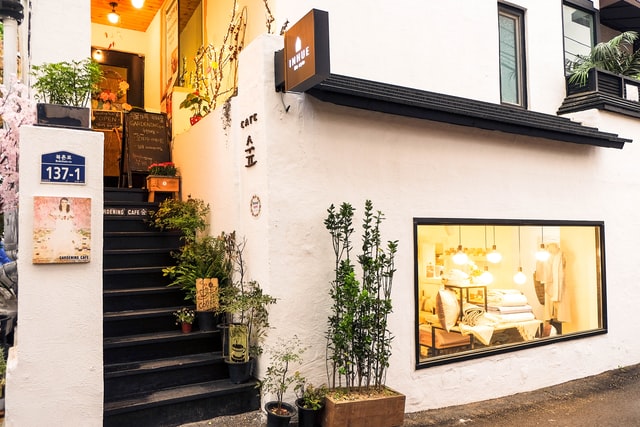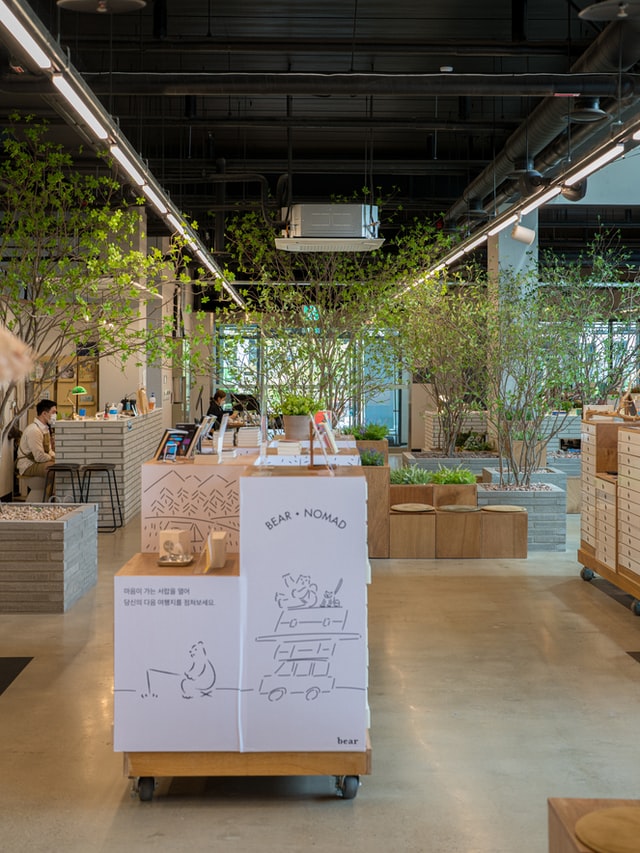
Introduction
Cafes are a staple in modern Korean society. The busy streets of Seoul are dotted with small oases offering americanos, smoothies, lattes, and cakes. Even pastries and cakes renowned for their difficulty and the expertise needed to make, such as macarons, croissants, and mille-crepe, are available as an everyday snack for a simple 4,000 won. Walking into a cafe, one can get a snapshot of Korean life. Couples sit, leaning into each other over a slice of fresh cream cake decorated with strawberries. Office workers make polite conversation over a set of iced americanos. Students hunch over their laptops, their drinks forming small pools of condensation over long hours of studying. Older women catch up with each other while holding cups of hot tea. Cafes essentially act as a form of public space in Seoul, being a major part of any person’s social life.
Korean cafes have become an institution, and the history of Korean cafes show a clear evolution and development since their earliest conception. While there was a slow incorporation of coffee into Korean life over the 20th century, there was development of cafe culture at an exponential rate entering the 21st century, resulting in the environment we see today.
History of Korean Cafes
There is a popular legend that states King Gojong had the first cup of coffee in Korea. The veracity of this story is up for debate, but it coincides with the opening of the first coffee shop in Seoul in 1902. Japanese occupation led to the introduction and expansion of coffee to the public, as Japanese-style coffee shops appeared throughout the peninsula.
Following the Korean War, there were the beginnings of the cafe culture we see today. While there were only a few thousand stores at the time (for comparison, Starbucks alone now has over 1,000 stores in Korea), they served a similar purpose to the cafes of today. We refer to these sorts of businesses as dabang (다방). Dabang originally refers to tea ceremony rooms that date back to the Three Kingdoms period, but after liberation and the Korean war, dabang became cafe-like facilities that served various social purposes. Coffee and tea were served, but the importance of dabang is its role as a meeting space. Dabang was a place for couples to meet and have dates, salarymen to greet and talk with guests, and self-employed people to work and do business. They even acted as strongholds during the Democratization Protests of the 1980s. Dabang set the stage for the social aspect of modern cafes.
Starbucks cannot be understated in its contribution to modern cafe culture. Until the opening of Starbucks’ first Republic of Korea location in 1999, many Koreans were consuming coffee in the form of instant coffee sticks. Starbucks introduced a level of expertise into coffee drinking, and this signaled the start of barista culture that still is strong today. Starbucks’ entry into the country signaled a major shift in coffee culture and brought the nation into a new era of cafes and coffee.
The Starbucks experience is now ubiquitous around the world, yet there are key elements of Korean Starbucks that show its reflexive relationship to Korean cafe culture, both shaping and taking influence from it. Starbucks is the blueprint for the atmosphere and menu of many coffee shops around the country, but Starbucks itself has had to make major alterations to its own menu to adapt to Korean palettes. Next to its signature white chocolate mocha and caramel macchiato are a Jeju mugwort cream frappuccino, strawberry yogurt smoothie, and sweet potato cake. Starbucks is a testament to the crystallization of Korean cafe culture, as the franchise must continually adapt to the existing culture as it grows its franchises.
 Modern Korean Cafes
Modern Korean Cafes
As stated earlier, cafes are a form of public space in South Korean cities. They act as the center to many people’s social lives, as friends, couples, and families all gather to sit and talk for hours. Due to their popularity, cafes are becoming an oversaturated market. Walking the streets, especially near a university or trendy neighborhood, one will see dozens of cafes lining the streets. This leads to major competition among cafes which therefore try to diversify based on customers’ wants. Many cafes now need to offer some sort of speciality to stand out amongst the crowd. Some take the food route, for example, branding themselves as waffle, ice cream, or cake cafes. However, many put most of their effort into the design and physical space of their location. This has led to immense creativity in aesthetics and layouts. There are cafes themed after popular media, like Harry Potter or Sherlock Holmes. There are also study cafes where seats are arranged in pod-like booths so customers can spend hours working without interruption. While the image of these locations is tied to their social media presence and reputation for drawing influencers, the tradition of themed cafes goes back to dabang, as speciality dabang were in operation as early as the 1930s.
Korean cafes are also now famous internationally for their menu, atmosphere, and prices. Cafe vlogs are a new genre of YouTube channel where cafe workers film themselves making drinks during a shift. Some of these channels can gain millions of views, and the comments are filled with people from all over the world expressing their desire to visit Korea and try all the drinks they see in these videos. This adds another element to the already massively popular Hallyu phenomenon. Now cafes are added to the list of globally trending Korean cultural products, such as dramas, skincare, and food. However, tourists coming to Seoul will quickly find themselves spending hundreds of their budget on cafes, especially in neighborhoods like Hongdae or Seongsu.
Cafes and Society
The plethora of cafes is indicative of some slight problems, especially in the metropolitan areas of the country. The general success and popularity of cafes has led many to try running their own businesses to take advantage of the cafe craze. The Korean restaurant industry is already incredibly competitive, and when factoring in the effect COVID has had on the economy, the failure rate for these sorts of enterprises is incredibly high. While many people may be led into starting a cafe at the chance of a decent salary and the autonomy of entrepreneurship, they may quickly find themselves in debt trying to keep up with Seoul rent prices and a customer base with infinite choices. Owners are not the only ones with troubles; the customer base also reveals a major issue in Korean society. As Korea evolves into a gig economy, the amount of freelancer and irregular workers is increasing rapidly. Companies do not extend the same benefits and privileges to these workers, meaning cafes have essentially the office for thousands of irregular workers around the country. Considering this trend, we can predict that cafes will only become more important as workers search for a replacement to traditional work spaces.
Written by: Curtis Feldner
Originally from Atlanta, Georgia, USA. Currently a 4th Year undergraduate pursuing a BS in Educational Studies at University of Wisconsin-Madison. Exchange student at Korea University and intern at VANK (Voluntary Agency Network of Korea)